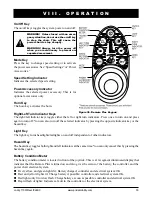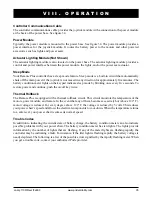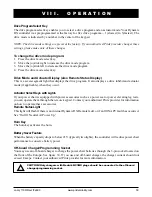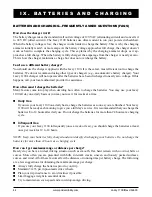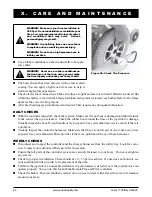
44
www.pridemobility.com
Jazzy 1100/RevJ/Feb03
I X . B A T T E R I E S A N D C H A R G I N G
BATTERIES AND CHARGINGFREQUENTLY ASKED QUESTIONS (FAQS)
How does the charger work?
The battery charger takes the standard wall outlet voltage of 120 VAC (alternating current) and converts it
to 24 VDC (direct current). The Jazzy 1100 batteries use direct current to run your powered wheelchair.
When the battery voltage is low, the charger works harder to charge the battery. This is why the charging
ammeter initially reads 5 or more amps. As the battery voltage approaches full charge, the charger doesnt
work as hard to complete the charging cycle. This explains why the charging ammeter drops as it ap-
proaches a full charge. When the battery is fully charged, the amperage from the charger is nearly at zero.
This is how the charger maintains a charge but does not overcharge the battery.
Can I use a different battery charger?
You should use the charger supplied with the Jazzy 1100. It is the safest, most efficient tool to charge the
batteries. We do not recommend using other types of chargers (e.g., an automotive battery charger). Your
Jazzy 1100s charger will not operate after the batteries have been discharged to nearly zero voltage. If this
happens, call your local authorized provider for assistance.
How often must I charge the batteries?
Many factors come into play when deciding how often to charge the batteries. You may use your Jazzy
1100 all day on a daily basis or you may not use it for weeks at a time.
n
Daily Use
If you use your Jazzy 1100 on a daily basis, charge the batteries as soon as you are finished. Your Jazzy
1100 will be ready each morning to give you a full days service. It is recommended that you charge the
batteries 8 to 14 hours after daily use. Do not charge the batteries for more than 24 hours at a charging
cycle.
n
Infrequent Use
If you use your Jazzy 1100 infrequently (once a week or less), you should charge the batteries at least
once per week for 12 to 14 hours.
NOTE: Keep your batteries fully charged and avoid deeply discharging your batteries. Do not charge the
batteries for more than 24 hours at a charging cycle.
How can I get maximum range or distance per charge?
Rarely do you have an ideal driving situation such as smooth, flat, hard terrain with no wind, hills or
curves. More often you are presented with hills, sidewalk cracks, uneven and loosely packed surfaces,
curves, and wind. All of these factors affect the distance or running time per battery charge. The following
are a few suggestions for obtaining the maximum range per charge.
n
Always fully charge the batteries prior to your trip.
n
Maintain 3035 psi in pneumatic drive wheels.
n
Plan your trip in advance to avoid inclines if possible.
n
Limit baggage weight to essential items.
n
Try to maintain an even speed and avoid stop-and-go driving.




